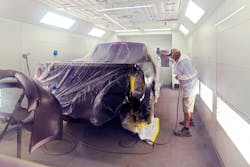Menefee: To Blend or Not to Blend, Who Pays Is The Question
Bumper to fender. Bumper to quarter panel. Trunk to quarter panel. Hood to fender. At some point in your shop’s life, I am sure you have had to blend paint for all of these groupings of parts. I am also positive you have gotten paid for some of those blends and some of them you have not. I am equally positive you have also NOT blended and wished you had because it caused problems down the line. My question is, do you have set guidelines for your paint department of when to blend and not to blend, even if you are not going to get paid for it?
First, let me preface this by saying, we always test our mixes on a spray out card for every single item we paint. If you are not doing a spray out card, then you are just taking a crap shot hoping that the color looks good and personally I am not gambler.
My rule in the paint booth is if we are getting paid to blend the paint then we better be blending it. If we are not getting paid to blend and we do a spray out card a couple of times and the color just needs to be blended into adjacent panels, then we just go ahead and blend it. Also, sometimes the spray out card looks spot on and then you lay the color down and because of the flop it just looks a bit off, and in that case, we fix it right then and there and blend. Why? Because I don’t want to have to repaint that vehicle at a later date and waste more money and time and throw off my production schedule.
If you don’t see repaints as a waste of time and money and completely throwing off your production schedule, then we need to talk. If you’re thinking to yourself that you’ve never had to repaint something because it wasn’t right, then you are lying to yourself. So, how much money is it really costing you when you have to repaint something because you did not get the color correct, or you did not blend when you should have?
To figure that out, let’s do a very long mathematical word problem. Let’s take an example of a bumper where the Insurance paid 2.3 hours at $65 an hour and $42 an hour for paint & supplies with no blend time. That gives you $246.10 to paint the bumper, not including any state taxes. Let’s assume you are making 30% on paint & supplies and you pay your painter $25 an hour on commission that would make your cost to paint that bumper $125.12, making you $120.98. Out of that $120.98 you made you still have to take out a cut for all of your overhead costs of doing business. Let’s be generous and say all of your overhead costs come out to 25% of your budget each year. So we take 25% ($30) out of that $120.98 we just made on that bumper, giving us a true profit of $90.98 or almost 37% profit, not bad.
Now what happens if we have to repaint this bumper? Do we just double all of our costs to find our true profit or loss? If we did, instead of making $246.10 on the painting of the bumper and profiting $90.98 of that, we go to actually losing $55.86, an almost 23% loss. But we also have to account for what happened to our production schedule because of that repaint. Did we have to push any cars back? Did we have to cover a day of a rental vehicle for someone? Did we have to pay any employees overtime to stay late to catch up the production schedule? All of those items add up and cost you money and make that 23% loss much greater.
What would have been the profit if we blended the fenders? Let’s say it’s an hour blend on each fender. What is our true cost for that? Our cost on paint labor is going to be $50 (two hours at $25 an hour) and supplies $58.80 (two hours at $42 an hour minus 30% profit we make on it). Add that to the initial cost of painting the bumper, $125.12, and our new cost to paint the bumper is $183.92. We add in our overhead cost of $30, making our total cost $213.92. Now we were only paid $246.10, so when we blend the fenders, we only end up making about a 13% profit.
When we run into this scenario, we always take pictures of the vehicle being blended and we always go back to the insurance company and request to be paid on that blend. Sometimes they pay us and sometimes they don’t, but in the long run I would still rather take a 13% profit over a loss because we had to repaint something or the consequences of a negative review or a customer that won’t come back to us. It’s just how I see business. If you haven’t run the numbers for yourself or given thought to your stance on blending panels when it’s not paid for, then you should.
About the Author
Tiffany Menefee
Tiffany Menefee has been the owner of Pronto Body Shop in El Paso, Texas, since 2015. She is also a former insurance adjuster.
